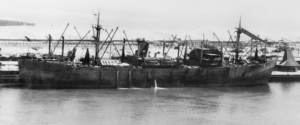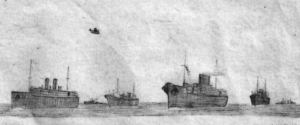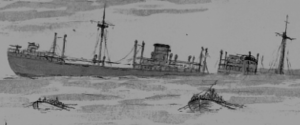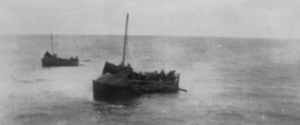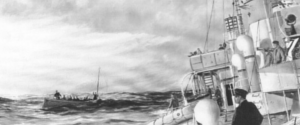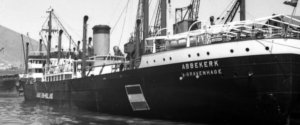Mozambique Channel: Near collision with enemy submarine

11 June 1942. Without cargo, Abbekerk now sails at high speed down the African coast, destination Durban, unaware of the Japanese activities around Madagascar. The crew starting to get more worried about German submarines.
It was a long distance to Durban but now, with the ship empty, we went along very well, the weather was good and it was like sailing in peacetime. Yet we knew and were well aware that on the East coast of Africa and around Capetown German long range U-Boats were operating and had torpedoed a number of ships. We were still a long way from there so were not too worried.
The only incident happened one night when we were sailing through the Mozambique Channel. We encountered a submarine on the surface that passed us going in the opposite direction at a distance of no more than forty metres. It was pitch dark and I have a feeling that on both sides a few hearts missed a beat. Nearly a head-on collision between two vessels moving at full speed. It was not identified and did not turn around because we did not see him again.
It was a distinct advantage to be on board a ship that could outrun a surfaced submarine.
Assistent engineer Adriaan Kik
[AcuGIS mapid=”1″]
In retrospect:
With all the facts available 75 years later, this is an interesting event. During this period it seems, neither German nor Allied submarines were active in this region. That only leaves the four large Japanese submarines mentioned in the previous episode. They wreaked havoc amongst the merchant navy ships in the Mozambique Channel. In no other month that many ships were sunk around South Africa as in June 1942. From the location of their attacks/victims (as shown on map) you can deduct that Abbekerk probably encountered I-16 or I-20.
In their time, they were both enormous submarines. Nearly three times the size as the standard German U boat. Length 110 meters, 2600 tonnes and 100 crew. Some were even equipped with mini submarines and I 10 even had a spotter (float) plane on board.

Submarine I-10 of the A1 class. In june 1942 she carried a spotter plane that overflew Durban
(Source: wikipedia)
During that period ships sailed without lights and the lighthouses and other navigational lights were extinguished. On clouded moonless nights the visibility was nil. But the chances of a collision or stranding because of navigational errors was far less than the chances of being sunk because of the lights. What would have happened had both ships collided with a collective speed of 34 knots (65 km/h) remains speculation. The submarine with its vulnerable pressured hull would surely not have survived the confrontation. Abbekerk probably would have but would have been severely damaged. But in all likelihood – with a head on collision – the submarine’s torpedoes would have fired from the impact, leaving both ships wrecked.
But as it happened they were 40 meters apart. Empty Abbekerk immediately geared up to her top speed of more than 20 knots and probably brought herself out of torpedo reach by the time the large submarine had turned around. The cannon on Abbekerk’s back deck was prepared but the submarine was nowhere to be seen. The submarine, if it did chase Abbekerk, had a top speed of 23 knots and would have stopped the chase early on because of it’s fuel consumption or because Abbekerk was already out of sight. A slower ship would not have stood a chance.
Because of the massacre in merchant shipping the submarines caused, the Admiralty rerouted ships that came after Abbekerk around Madagascar and no longer through the Mozambique Channel.

